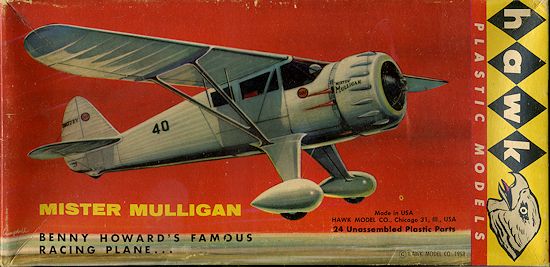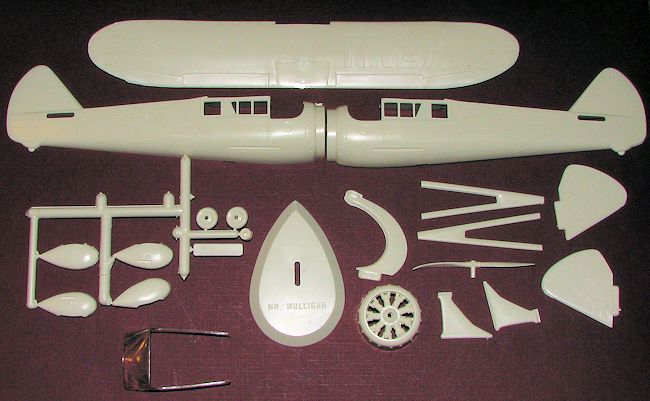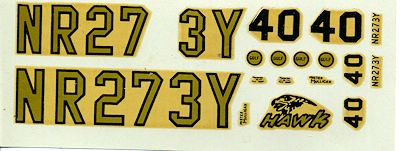
Hawk 1/48 Howard DGA.6 'Mr Mulligan'
| KIT #: | 619 |
| PRICE: | 60 cents when new |
| DECALS: | One option |
| REVIEWER: | Scott Van Aken |
| NOTES: | Box is dated 1958 |

| HISTORY |
The Howard DGA-6 was a pioneer racing plane, nicknamed Mister Mulligan. It was the only airplane ever designed for the specific purpose of winning the Bendix Trophy. The plane was designed and developed by Ben Howard and Gordon Israel, who later became an engineer for the Grumman Aircraft Engineering Corporation. Mister Mulligan was designed to fly the entire length of the race nonstop and at high altitude. Neither had ever been done before. Mister Mulligan won the trophy, and thus changed the way in which long distance airplanes were designed.
The Bendix Trophy was a cross-country race from the west coast to the site of the National Air Races in Cleveland, Ohio, and typically was the starting event of the week-long aviation festival. The Thompson Trophy was awarded to the winner of the unlimited division in close-course pylon racing at the National Air Races.
The sole original DGA-6 was constructed in 1934 in the defunct factory of the American Eagle-Lincoln Aircraft based at Fairfax Airport in Kansas City Mo. It featured a steel tube fuselage with a plywood-skinned wing. Howard freely admitted he was inspired by "seeing the Monocoupe from the wrong end" during air races; The DGA-6 can thus be termed an "overgrown Monocoupe".
While en route to the 1934 air races, oxygen and fuel system problems caused an off-field landing which damaged the gear and propeller. The aircraft could not be repaired in time and missed the 1934 season.
In the 1935 Bendix race the aircraft was loaded with 300 gallons of gasoline, 30 gallons of oil and oxygen equipment for two giving it the ability to fly for 7 hours at 22,000 feet (6,700 m). At that load the aircraft required 1,500 feet (460 m) of runway and had an initial climb out of close to 2000 ft/min.
Howard and Israel flew the DGA-6 in the 30 Aug. 1935 Bendix and won with a speed of 238.70 m.p.h., and Harold Neumann racing the DGA-6 flew at 220.19 mph (354.36 km/h) in winning the 2 Sept. 1935 Thompson Trophy at the 1935 National Air Races. No other pilot or single aircraft had ever won both races. Howard's DGA-6 also had the distinction of being the only racer during the golden age of airshows to evolve into a successful commercial production aircraft, first as the DGA-8 and DGA-9, and later the DGA-11 and DGA-12.
Howard's engineering advantage was his low-drag airframe and the use of the 850 horsepower (630 kW) Pratt & Whitney Wasp radial. The fuel capacity of the four-seat Mister Mulligan made the difference in the Bendix race as Howard and Israel beat Roscoe Turner by less than a minute thanks to two fewer fueling stops in the race from Burbank, California, to Cleveland, although Turner's 1,000 hp (750 kW) Pratt & Whitney Hornet on his Wedell-Williams Model 44 racer gave him the power advantage.
Mister Mulligan broke Wedell-Williams' three-year streak of wins in the Bendix. By the end of the week, Howard and his DGA-6 replaced Wedell-Williams as the rising star of aviation by upsetting defending champion Turner in the Thompson race after he was forced out. Newspapers hailed the 1935 event as the "Ben Howard National Air Races".
Unfortunately, the DGA-6's days on the national air race scene were limited. The next year, Howard and his wife Maxine were injured when Mister Mulligan lost a propeller blade and crash-landed near Crownpoint, New Mexico during the latter stages of the 1936 Bendix (New York - Los Angeles) race. Howard recovered from the serious injuries resulting from the crash, but lost a leg in the accident and Mister Mulligan was destroyed. Roscoe Turner met a similar fate, ground-looping on a rough field in Texas. The misfortunes of Howard and Turner opened the way for Arkansan Louise Thaden in her Beechcraft Staggerwing to become the first woman to win a national air trophy.
The success of Mister Mulligan led to the formation of the Howard Aircraft Corporation on January 1, 1937.
| THE KIT |
 Dated 1958 on
the box, this one sure looks like an original issue with its somewhat brittle
instruction sheet and very dated drawings on one side and photos on the other.
Dated 1958 on
the box, this one sure looks like an original issue with its somewhat brittle
instruction sheet and very dated drawings on one side and photos on the other.
The kit is in white plastic with a single clear piece. There is no interior but there is a pilot. Even the engine is molded into the cowling and is only the front half of the engine. One will need to paint the inside of the cowling and the interior in black as one can see through the cowling into the empty interior. Not shown in the photo is the pilot figure and the landing gear spreader bar.
The rather toy-like wheels are trapped in the pants
halves and attached to the lower landing gear legs. The upper strut braces are
already molded into the underside of the wings. All of the parts have ejector
pin marks somewhere on them with a few being on the inside and others on the
outer surfaces of the parts. The lone clear piece is designed to insert after
the airframe is built. There are no frame lines with the side window frames
being behind the clear piece. I have seen this model built up and it
looks distinctly odd. Masking the side portions after it has been installed may
well work if one can overcome the 'reflection'
 issue derived
from the thickness of the clear between the exterior and interior frames. It is
a poser.
issue derived
from the thickness of the clear between the exterior and interior frames. It is
a poser.
Typical of the time, the markings placements are clearly embossed on the airframe. One could probably paint on many of the markings, which is a good thing as the decals are pretty useless as they are, having yellowed quite badly over the last 55 years.
| CONCLUSIONS |
As you might guess, this is a kit that is for the nostalgic amongst us or for those who want to add this important racer to our collections. The brave will put a lot of work into building an interior, replacing the engine and other niceties. The new Hawk company seems little interested in reissuing the Hawk aircraft catalogue being more interested in the wierd-os and other non aviation subjects.
| REFERENCES |
http://en.wikipedia.org/wiki/Howard_DGA-6
April 2013
Thanks to me for grabbing this one when I saw it.
If you would like your product reviewed fairly and fairly quickly, please contact the editor or see other details in the Note to Contributors.